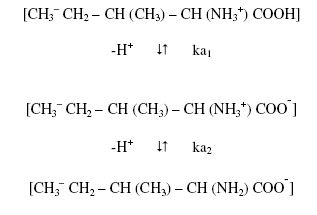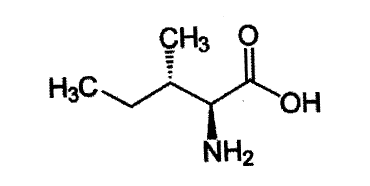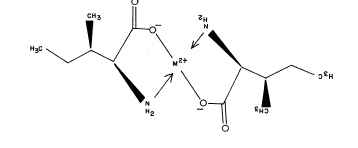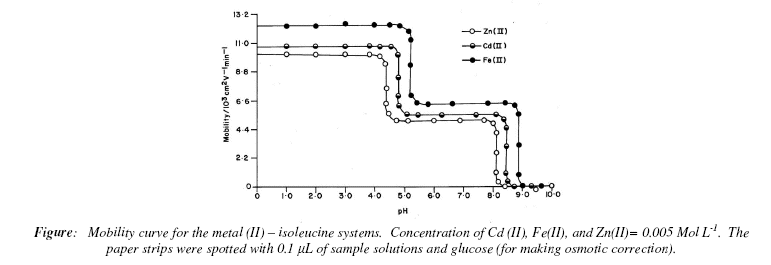Revista Boliviana de Química
versión On-line ISSN 0250-5460
Rev. Bol. Quim vol.32 no.1 La Paz abr. 2015
ARTICULOS ORIGINALES
Interaction of isoleucine with metal ions in chemical and biological systems
Brij B. Tewari*1, Ashish K. Tiwari2,3
1Department of Chemistry, Faculty of Natural Sciences, University of Guyana, P. O. Box: 101110, Georgetown, Guyana
2Indian Institute of Technology IIT-Kanpur, Kalyanpur, Kanpur, Uttar Pradesh 208016, Tel. +91 512 259 0151 Kanpur, India
3Indian Institute of Technology IIT-Jodhpur, Old Residency Road, Ratanada, Jodhpur, Rajasthan, Jodhpur, R]ajasthan 342011, India, Tel. +91 291 244 9013, Jodhpur, India
*Corresponding author: brijtewari201 1@yahoo.com
Abstract
The stability constants of Zn2+, Cd2+ and Fe2+ complexes with isoleucine were determined by paper ionophoretic technique. The present method is based on the movement of a spot of metal ions in an electric field at various pHs of background electrolyte. A graph of pH versus mobility was used to obtain information on the binary complexes and to calculate its stability constants. Using this method, the stability constants of binary complexes metal(II) -isoleucine have been determined to be (7.24 ± 0.01, 3.48 ± 0.04); (6.90 ± 0.01, 3.25 ± 0.11) and (6.50 ± 0.03, 2.97 ± 0.07) (logarithm stability constant values) for Zn(II), Cd (II) and Fe(II) complexes respectively at ionic strength 0.01 Mol L-1 and a temperature of 35°C.
Keywords: Stability constants, paper ionophoretic technique, isoleucine, zinc (II) complexes, cadmium (II) complexes and iron(II) complexes.
Spanish title: Interacción de isoleucina con iones metálicos en sistemas químicos y biológicos.
INTRODUCTION
Data on the complexation of metal ions and the bioactive ligand isoleucine gives an important insight into many physiochemical processes. Iron and zinc are classified as essential metals without which life cannot sustain. Cadmium is a toxic metal which is harmful even at very low concentration. The normal and toxic level in human diet (mg/day) are (0.007 - 0.3; 3.0 - 330.0), (6.0 - 10.0; 200.0) (5.0 - 40.0; 150 - 600) for cadmium, iron and zinc, respectively [1]. The most salient toxicological property of cadmium is its exceptionally long half life in the human body. On absorption cadmium irreversibly accumulates in human body, in particularly in kidney, lung and liver. In addition to its extraordinary cumulative properties, cadmium is also a highly toxic metal that can disrupt a number of biological systems, usually doses that are much lower than most toxic metals [2]. Cadmium has several adverse effect in the biological systems [3-10]. Iron is vital for almost all living organisms by participating in a wide variety of metabolic processes including oxygen transport, DNA synthesis, and electron transport. Excessive iron leads to tissue damage, as a result of formation of free radicals. Disorder of iron metabolism causes anemia and neurodegenerative disease [11]. Iron (II) have significant biomedical applications but are toxic at higher concentration [12-18]. Zinc (II) ion is known to be one of the important essential trace elements found in biological systems and also in many metallo-proteins and metallo-enzymes which exist in living organisms [19]. Zinc (II) is well known for its biological significance and toxicity [20-25].
Isoleucine is a α-acid with the chemical formula HO2C CH (NH2) CH (CH3)CH2 CH3. It is an essential amino acid, which means that human cannot synthesize it, so it must be ingested. Its codons are AUU, AUC and AUA, which a hydrocarbon side chain, isoleucine classified as a hydrophobic amino acid. Together with threonine, isoleucine is one of two common amino acids that have a chiral side chain. Foods that have high amounts of isoleucine include eggs, soy protein, seaweed, turkey, chicken, lamb, cheese and fish. Isoleucine has several significant applications in biological systems [26-32]. Kiso has done a comprehensive study on paper ionophoretic migration of metal complexes. The present electrophoretic technique is free from a number of defects such as capillary flow on paper, adsorption, electro-osmosis and temperature during electrophoresis. It gives results in fair agreement with accepted literature values.
Publications [33-35] from our laboratory described a new method for the study of binary complexes. The present work is the extension of the techniques and report my observations on nature and stability constants of Zn (II) / Cd (II) / Fe (II) - isoleucine binary complexes.
RESULTS
Chemical literature [36, 37] confirms that anionic species of amino acids are the sole ligating species for the metal ions. The ionophoretic mobility of the metal spot against pH gives a curve with number of plateaus is shown in Figure.
The every plateau is indicative formation of a certain complex species. The first one in the beginning corresponds to a region in which metal ions are uncomplexed. In this region of low pH, concentration of [ CH3 -CH2 - CH (CH3) - CH (NH3+) COOH] species of isoleucine is maximum and this species is non-complexing, beyond this range, metal - ion spots have progressively decreasing mobility, complexation of metal ions should be taking place with anionic species of isoleucine whose concentration increases progressively with increase of pH. Figure shows three plateaus in all Cd(II), Fe(II) and Zn(II) metal ions, which indicates formation of two complexes with isoleucine anion. Figure disclose that Cd(II), Fe(II) and Zn(II) ions form their first complex movement towards negative electrode. Hence, one [CH3 - ch2 - ch (CH3) - ch (NH2) COO- ] must have combined with Cd (II), Fe(II) and Zn(II) ions to give [Cd{ CH3 - CH2 - CH (CH3) - CH (NH2) COO}]+ , [Fe{ CH3 - CH2 - CH (CH3) - CH (NH2) COO}]+ , [Zn{ CH3 - CH2 - CH (CH3) - CH (NH2) COO}]+ complex cations, respectively. With further increase of pH, the mobility of all three metal ions decreases, giving rise to a third plateau with zero mobility, indicating its neutral nature. The third plateau in each case is due to a 1:2 metal - ligand complex. Hence, two isoleucine anionic species [ ch3 - ch2 - ch (CH3) - ch (NH2) COO- ] must have combined with Cd2+, Fe2+ and Zn2+ to give [ Cd {CH3 - CH2 - CH (CH3) - CH (NH2) COO}2], [Fe { CH3 - CH2 - CH (CH3) - CH (NH2) COO}2] and [ Zn {CH3 - CH2 - CH (CH3) - CH (NH2) COO}2] metal complexes, respectively. In view of above observation, the complexation of metal ions with the isoleucine anion may be given as
wherein, M2+ represent Cd2+, Fe2+ and Zn2+ metal cations, [L ] is the isoleucine anion, K1 and K2 are the first and second stability constants, respectively. The spot is moving under the influence of electric field, the overall mobility is given by equation
Wherein, un and fn are mobility and mole fractions of particular complex species, respectively.
This equation is transformed into the following useful form on taking into consideration different equilibria
Wherein, uo, u1 and u2 are the mobilities of the uncomplexed metal ions, 1:1 and 1:2 metal complexes, respectively. This equation has been used for calculating stability constant of complexes of metal ions with isoleucine. For the calculation of first stability constant K1, the region between the first and second plateau is pertinent. The overall mobility U will be equal to the arithmetic mean of mobility of uncomplexed metal ion, u0 and that of the first complex, m, at pH where ![]()
The dissociation constants of the pure isoleucine is determined by using same paper electrophoretic technique. The values first and second dissociation constants for the pure isoleucine is found to be 2.25 and 9.62, respectively. These values are similar to literature values [38]. The mode of dissociation of pure isoleucine can be represented as:

The concentration of complexing isoleucine [L-] is calculated with the help of equation

Wherein [L T] is the total concentration of isoleucine and ka1 and ka2 are the first and second dissociation constants of pure isoleucine, respectively. The stability constant K2 of second complex can be calculated by taking into consideration, the region between second and third plateau of mobility curve. The calculated values of K1 and K2 are given in Table.
DISCUSSION
It is clear from the table that first and second stability constants follow the order
![]()
It is observed from the table that the calculated stability constant values are similar to literature values. The slight deviation in the values obtained from different sources is mainly due to the difference in temperature and ionic strength used by different workers. The second stability constant values are found to be lower in comparison to the first stability constant in each cases, this may be due to the decrease in coordinating tendency of ligand with higher state of aggregation [39].
According to standard deviation (statistics) the precision of the method is limited to that of paper electrophoresis and uncertainty in the result is ± 5 %. Hence, it cannot immediately replace the most reliable methods, even though it is a new approach deserving further development. The molecular structure of isoleucine is given as:

The high stability constant values of zinc (II) - isoleucine binary complexes indicate strong bonding between zinc cation and oxygen donor isoleucine anion. The low stability constant values of iron (II) - isoleucine binary complexes indicate weak bonding between iron (II) cation and oxygen donor isoleucine anion. Although anionic species is same in all complexes the strength of bonding and values of stability constant and various complexes may also be depended on nature and electronic configuration of different metal cations. The proposed structure for ML2 complexes may be given as:

Wherein, M is metal cations Cd2+, Fe2+ and Zn2+.
CONCLUSIONS
The main conclusions drawn from present study are as follows:
1. Cadmium (II), iron (II) and zinc (II) are significant for biological systems as such they are toxic at high concentration. The isoleucine may be used to reduce the level of these metal ions in living systems.
2. The ML2 complexes are found to have lower stability constant values in comparison to stability constants of ML+ complexes in each case.
3. These biologically significant metal complexes can be prepared on large scale at particular pH of the background electrolyte solution.
4. The zinc (II) - isoleucine and iron (II) - isoleucine complexes are found to have highest and lowest stability constant values, respectively.
5. The present modified electrophoretic technique is helpful in finding if complexes are formed or not, and if formed their stability constants can also be determined.
EXPERIMENTAL
Instruments
Systronics (Naroda, India) paper electrophoresis equipment horizontal-cum-vertical type, model 604, has been used. The apparatus consisted of a PVC moulded double tank vessel. In our laboratory significant change in the instrument has been made. Two hollow rectangular plates covered with thin polythene sheets have been used through which thermostated water is run for controlling the temperature. The tanks were closed with a transparent PVC moulded lid. The whole assembly is tight, which prevent moisture changes, which may upset the equilibria in a paper strip. This assembly design thus keeps to a minimum the disturbing effects of evaporated from the unwanted liquid flow in the paper. Each electrolyte tank contains a separate electrode chamber. The auxillary unit is specially designed to operate either voltage mode or on current mode.
Elico (Hyderabad, India), Model L1-10, pH meter using a glass and calomel electrodes assembly working on 220 V/50 Hz established a.c. mains, was used for the pH measurements.
Chemicals
Solutions of Cadmium (II), iron (II) and zinc (II) metal perchlorates were prepared preliminary precipitation of metal carbonates from 0.1 Mol L-1 solution of sodium carbonate (chemically pure grade, BDH, Poole, UK). Which were washed with boiling water and treated with calculated amounts of 1%, A.-R grade perchloric acid. These were boiled on water bath and filtered. The metal contents of the filtrates were determined and concentration kept at 0.005M [40].
Metal spots were detected on the paper using dithizone in CCl4 for Zn(II), 0.1 % solution of 1-(2-pyridylazo) - 2 - naphthol (PAN) (E. Merck, Darmstadt, Germany) in ethanol was used for detecting the iron(II) and cadmium(II) metal ions.
A 0.005M (BDH, AnalaR) solutions were prepared in water and used as electro-osmotic indicator for the correction due to electro-osmosis. A saturated aqueous solution (0.9 mL) of silver nitrate was diluted with acetone to 20 mL . Glucose was detected by spraying with this silver nitrate solution and then with 2 % ethanolic sodium hydroxide, when a black spot was formed.
Background electrolyte (BGE)
Stock solution of 5.0 M perchloric acid was prepared from its 70 % solution (SDS, AnalaR grade). 2.0 M sodium hydroxide and 0.5 M isoleucine (BDH, Poole, UK) solutions were prepared. The background electrolyte used in the
study of binary complexes were 0.1 M perchloric acid and 0.1 M isoleucine. The system was maintained at various pH by the addition of sodium hydroxide.
Procedure
For recording observation of particular metal ion, two strips were spotted with the metal ion solution along with additional two spotted with glucose using 1.0 uL pipette and then mounted on the insulated plate. The hollow base plate in the instrument was made horizontal using a spirit level and 150 - mL volume of BGEs containing 0.1M perchloric acid and 0.01 M isoleucine was placed in each of the two tanks of the electrophoretic apparatus. The paper become moistened with the BGEs solutions due to diffusion. The second insulated plate was placed on paper strips and then thermostated water (35° C) was circulated in the plates to keep the temperature constant. The lid was then placed on the instrument to make it air tight. It was left for 15 minutes to insure wetting of strips. Subsequently 200 Volts potential was applied between the tank solutions to initiate electrophoresis. The electrophoresis was carried for 60 minutes after which the paper strips were taken out by means of glass rod, dried on a horizontal platform and the spots detected. The observations were repeated for different pH values of BGE (variation in pH was made by addition of sodium hydroxide solution). The differences in the distances in the duplicates were noted for the calculation. The distance travelled toward the anode was assumed to be negative and that toward cathode positive. The actual distance of the sample plot was measured after taking into account the distance travelled by the reference glucose spot. Ionophoretic observations on metal ions were recorded at various pH values of the BGEs obtained by adding sodium hydroxide solution, the ionic strength being maintained at 0.1 M. The observed mobility of migrant was calculated by using the formula.

After applying the correction factor the observed mobility is given as:

Where U = mobility of metal ion / complex ion; d = mean of duplicate distance travelled by metal ion / complex ion; dG = mean of duplicate distance travelled by glucose spot; x = field strength; t = time for electrophoresis.
The mobility of metal / complex ion spots on the paper strips were thus calculated and are reported with different pH values. The mobility curves for the metal (II) - isoleucine system is shown in Figure.
REFERENCES
1. Banerjea, D., Everyman's Sci. 1995, 29(6), 176. [ Links ]
2. Bernard, A., Indian J. Med. Res. 2008,128, 557 [ Links ]
3. Panich - DAT, T., Upatham, S., Pokethitiyook, P., Kruatrachue, M., Lanza, G. R. J., Environ. Protect. 2010,1, 431 [ Links ]
4. Das, P., Samantar, S., Rout, G. R., Envion. Pollu. 1997, 98(1), 29. [ Links ]
5. Green, M., Smyth-Boyle, D., Harries, J., Taylor, R., Chem. Commun. 2005, p. 4830. [ Links ]
6. Jia, Y., Lin, J., Mi, Y., Zhang, C., Reprod. Toxicol. 2011, 37(4), 477. [ Links ]
7. Krystofova, O., Zitka, O., Krizkova, S., Hynek, D., Kizek, R., Int. J. Electrochem. Sci. 2012, 7, 886. [ Links ]
8. Schubert, J., Derr, K., Nature 1978, 275, 311. [ Links ]
9. Bai, H., Zhang, Z., Guo, Y., Jia, W., Nanoscale Res. Lett. 2009, 4, 717. [ Links ]
10. Peralta - Videa, J. R., Lopez, M. L. Narayan, M., Saupe, G., Gardea - Torresdey J., Int. J. Biochem. Cell Biol. 2009, 41, 1665. [ Links ]
11. Lieu, P. T., Heiskala, M., Peterson, P. A., Yang, Y., Mol. Asp. Med. 2001, 22, 1 [ Links ]
12. Callura, J. M., Cantor C. R., Collins J. J., PNAS, 2012,109(15), 5850 [ Links ]
13. Harrington, M. J., Masic, A., Holten-Andersen, N., Waite, J. H., Fratzl, P., Science, 2010, 328, 216 [ Links ]
14. Mahmoudi, M., Simachi, A., Imani, M., J. Iran. Chem. Soc. 2010, 7(1), S1
15. Braun, V., Front. BioSci. 2003, 8, 1409 [ Links ]
16. Fraga, C. G., Mol. Asp. Med. 2005, 26, 235 [ Links ]
17. Mesa, M. M., Macias, M., Cantero D., Chem. Biochem. Eng. 2002,16(2), 69 [ Links ]
18. He, X., Open Biomed Eng., 2011, 5, 47 [ Links ]
19. Yoshikawa, Y., Veda, E., Suzuki, Y., Yanagihara, N., Sakurai, H., Kojima, Y., Chem. Pharm. Bull. 2001, 49(5), 652 [ Links ]
20. Carpentieri, U., Myers, J., Daeschner, C. W., Haggard, M. E. ,Biol. Trace Element Res. 1988,16(2), 165 [ Links ]
21. Broomel, C. C., Mattoni, M. A., Z0k, F. W., Waite, J. H., J. Exp. Biol. 2006, 209(pt. 16), 3219 [ Links ]
22. Anzellotti, A. I., Farrell, N. P., Chem. Soc. Rev. 2008, 37, 1629 [ Links ]
23. Barrea, R. A., Perez, C. A., Ramos, A. Y., J. Synchrotron. Rad. 2001, 8, 990 [ Links ]
24. Tuncay, E., Bilginoglu, A., Sozmen, N. N., Zeydanli, E. N., Ugur, M., Vassori, G., Turan, B., Cardiovasc. Res, 2011, 89(3), 634 [ Links ]
25. Chang, C.- H., Hu, Y. -T., Lo, C. -F., Luo, L., Lin, H. -M., Wu, T. - K., Int. J. Biol. Sci. 2011, 7(8), 1203 [ Links ]
26. Piecyk, M., Srama, A., Bzducha, A., Obiexzinski, M., Acta Sci. Pol. Technol. Aliment. 2007, 6(2), 5 [ Links ]
27. Facchini, P. J., Ann. Rev. Plant Physiol. Plant Mol. Biol. 2001, 52, 29 [ Links ]
28. Hibi, M., Kawashima, T., Kodera T., Smirnov, S. V., Sokolov, P. M., Sugiyama, M., Shimizu, S., Yokoseki, K., Ogawa, J., Appl. Environ. Microbiol. 2011, 77(19), 6926 [ Links ]
29. Alam, H., Raqib, R., Ashraf, H., Qadri, F., Ahmed, S., Zasloff, M., Agerberth, B., Salam, M. A., Gyrm N., Meier, R., J. Health Popul. Nutr. 2011, 29(3), 183 [ Links ]
30. Yang, X., Bing, T., Mei, H., Fang, C., Cao, Z., Shangguan, D., Analyst, 2011,136, 577 [ Links ]
31. Mohammadi, H. S., Omidinia, E., Lotfi, A. S., Saghiri, R., Iranian Biomed. J., 2007,11(2), 131 [ Links ]
32. Pressman, B. C., Ann. Rev. Biochem. 1976, 45, 501 [ Links ]
33. Tewari, B. B., Russ. J. Inorg. Chem. 2005, 53(3), 499 [ Links ]
34. Tewari, B. B., Bull. Chem. Technol. Macedonia 2005, 24(2), 109 [ Links ]
35. Tewari, B. B., Rev. Inorg. Chem. 2003, 23(4), 349 [ Links ]
36. Carty, J. A., Taylor, J. N., Inorg. Chem. 1977,16, 177 [ Links ]
37. Levason, W., Meauliffe, A. C., Johus, M. D., Inorg. Nucl. Chem. Lett. 1977,13, 123 [ Links ]
38. Martell, A. E., Smith, R. M., Critical Stability Constants, Vol. 1, Amino Acids, Plenum Press, New York, London, 1974 p. 12 [ Links ]
39. Joshi, J. D., Bhattacharya, P. K., J. Indian. Chem. Soc. 1980, 57, 336 [ Links ]
40. Kolthoff, I. M., Belcher, R.,Volumetric Analysis, Vol. 3, Interscience Publishers Inc. New York, USA, 1957 [ Links ]












 uBio
uBio 





